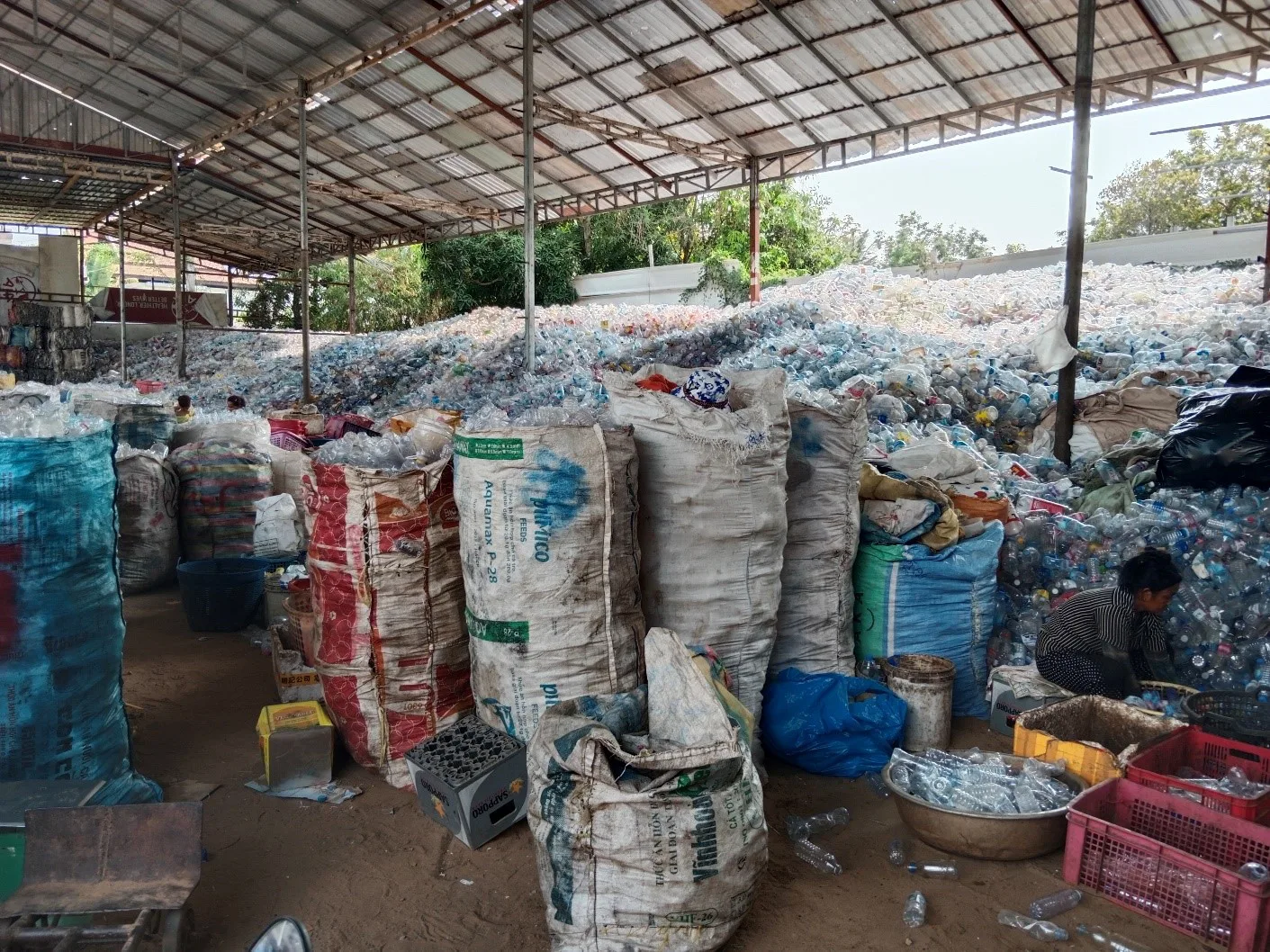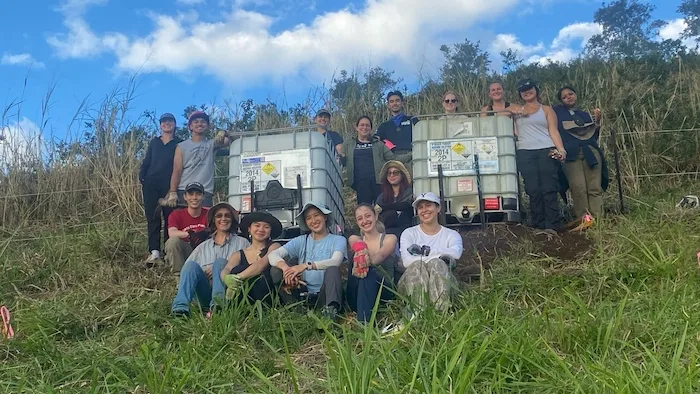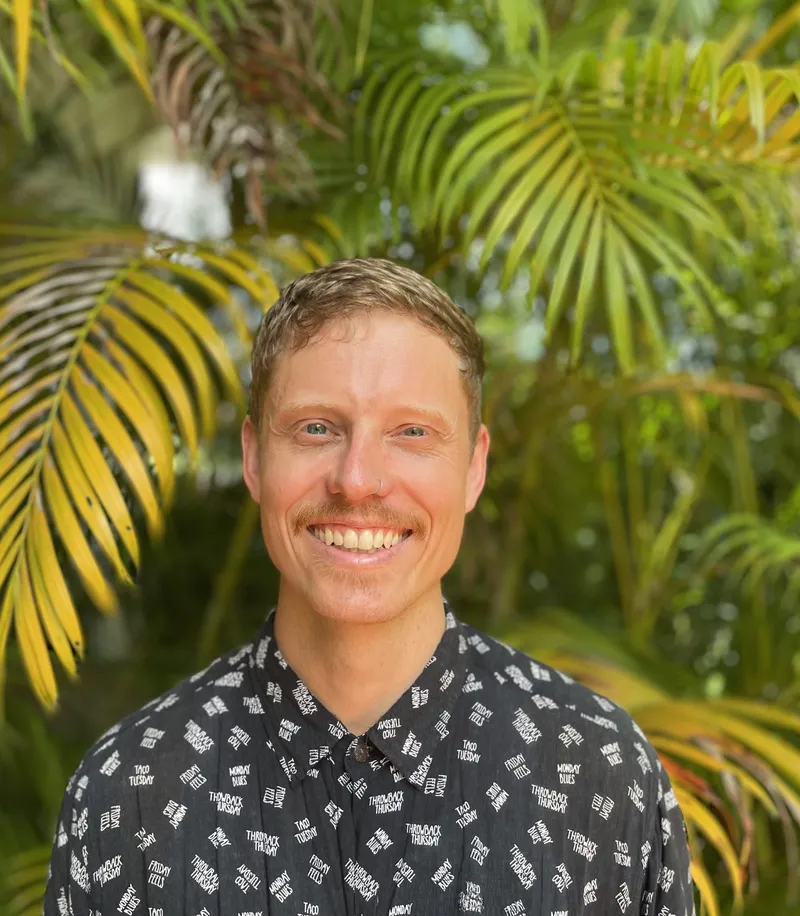Reduce, Re-use, Exploit.
A man in his 60s, who looks a lot older than he is, enthusiastically explains to us his daily waste picking schedule. “I usually head out in the morning and return for lunch and then leave again in the afternoon – sometimes sleeping overnight on the side of the road. But for me it’s ok I’m used to a tough life – I could sleep at any old place.” He grins and laughs and the people surrounding him momentarily lighten up, briefly forgetting their woes – “that grandpa snores like anything – nothing will wake him,” says a woman in her 40s who stays next to his hut. The man continues – “I’m disabled – and find it difficult to walk, but I have no problem riding.” The woman again chimes in – “we can’t get him to stop riding that bloody bicycle – just yesterday he rode 50 km from Banteay Srey to collect cans and bottles along the road.”
On average, the man only makes a little over a dollar per day from collecting aluminum cans and plastic water bottles that he sells to a local recycling center. But he adds that people often give me food and money as well, and several people purposefully keep cans to give to me. I guess they pity me… When he was younger he worked as a low paid mechanic and second hand electronic goods trader. But as he got older he found it difficult to work with his hands. Around the same time, cheap electronic goods flooded the market and he found it hard to get by. Landless, alone, and with no capital or assets he found himself squatting next to a pagoda in Siem Reap.
As he hobbles off to prepare his bike, I ask his neighbor what will happen when they are finally evicted from their corrugated iron and wooded huts sprawling along a laneway that is being flattened by provincial authorities. She pauses as if not entirely sure herself; we will find somewhere to rent…….cheap rent…. around town…. so we can keep doing recycling….” she says as her solemn expression reveals she is not entirely convinced by her own words. But we will take care of that grandpa wherever we go and make sure he’s fed. The residents always knew the time would eventually come when they were forced to leave – drawn by desperation and landlessness they managed to postpone the cruel market logics of rising land prices and gentrification for more than a decade.

Photo taken by Dr. Tim Frewer
Urban recyclers in Siem Reap have a contradictory existence. On the one hand their labor is peripheral to the needs of capital. They are the people excluded from labor markets due to age, sickness, caring responsibilities, indebtedness, or circumstance (rural migrants, deaths in the family, separation from partners etc.). It is in this desperate state that their labor meets with capital (in the form of depot owners who buy recyclable goods off them). Yet capital knows it has the upper hand and pays this fractured and injured work force a piece rate well below the cost of living. The average monthly income from our sample of 94 waste pickers was just over USD100. The recyclers have to scrabble together a livable income from precarious construction work, debt, begging and remittances.
For the poorest recyclers redistribution is an important part of their existence; like the old man, they work hard to get food, money and recyclable goods from those better off than them. So too their own mutual aid networks – mostly other recyclers – make sure the poorest do not go hungry. In a context where the state takes almost no responsibility for those who are too sick, old or burdened to earn income, these redistributive relations and mutual aid networks are crucial.
Yet simultaneously the labor of recyclers moves thousands of kilograms of material throughout the city every day. Their labor produces the most important environmental service in the city. Collectively, the unwaged recycler labor force is by far the most important and numerous labor force involved in solid waste disposal. Recyclers sift through undifferentiated waste throughout the city carefully removing aluminum cans, plastic bottles, cardboard and scrap metal. Even after disposal at waste dumps, hundreds of recyclers sift through piles of waste to extract recyclables.
How did it end up like this? They are the poor, sick, disabled, single mothers, elderly who are rejected from the formal labor force, and unable even to do small scale trading, squatting on marginal lands or barely making rent at the edges of the city. How did it happen that these people were drawn together due to discarded piles of bottles and cans?
To answer this, we have to first start with the waste.
The can started its life as a technology to feed European settlers as they fought wars and violently settled colonized lands. In its aluminum form, it helped to transport across the world the excesses of the colonial plantation system (sugar in the form of soda). The soda can was made of aluminum due to newly discovered industrial processes that could cheaply extract aluminum from bauxite ore (at great cost of energy – but which was subsidized by cheap fossil fuels, the cost of which is being paid now).
American smelting companies like Alcoa accumulated incredible profits through expanded war time production and the insatiable demand for sugary drinks that has not relented in the eight decades following the end of World War II. In that time the aluminum can -carrying a seemingly endless supply of cheap sugary drinks, has been exported to every corner of the world with little thought of what happens to the discarded waste. That the aluminum can is technically 100% recyclable was an afterthought – even in its home country it has only ever reached a 50% recycling rate. What chance does Cambodia have of dealing with an ever increasing mass of aluminum cans when the formal waste disposal system barely covers half the population?
The story of plastic bottles follows a similar trajectory. Bottled mineral water originated in 17th century England alongside the belief that mineral waters had special rejuvenating and healing qualities. By the mid-19th century, at the peak of scientific racism when the English were desperately looking for a scientific basis for colonial subjugation, these ideas had morphed into something new. Namely, that temperate spas (and their waters) were rejuvenating for the “white constitution” that was forged in the cool temperate climate, and due to colonialism was living in the dangerous tropics. Around the same time the French were setting up hill stations and colonial spas in Vietnam and Cambodia as a remedy to the perceived ills of the tropical climate (and tropical people). Mineral water was first bottled in glass bottles and became popular in Europe in the latter half of the 19th century. By the early 20th century mineral water had not yet caught on in the America – mostly due to the advent of chlorinated water which provided clean and safe drinking water to the population. This changed however with the creation of the plastic bottle.
The creation of the first plastic was spurred on by rising demand for ivory. European colonial projects had created both a rising supply and demand for ivory where Asian and African elephants in European colonies were forced to give up their tusks for billiard balls – a favorite game of colonial administrators and the European upper classes alike. The trend caught on in America and soon demand far surpassed supply. It was at this point the first plastic polymer was created. But it was World War II and the U.S military’s need for plastics that saw a boom in the burgeoning industry in applications that went well beyond upper class luxury goods. Post World War II, rising incomes and massive production of plastics using cheap oil, resulted in incredible diversification and demand for plastics. In 1973 US company DuPont patented the Polyethylene terephthalate (PET) bottle and since that time global production has increased exponentially. There was never really any thought given to recycling plastics by those who created them; plastic bottles have been recklessly promoted by petro chemical companies intoxicated on the profits of post-war North American mass consumerism. Now plastics production has spread across the world and again countries like Cambodia are faced with ever increasing imports of plastics, with very limited capacity to properly discard of them.
But back to the waste pickers. How did they end up where they are? Each story is unique; a young woman living in Siem Reap who lost her job during COVID-19, a middle aged man who was forced to sell his rice fields in a rural area a decade ago, a single mother who is the survivor of domestic abuse and has to raise three children on her own. They are mostly women (73% of our interviewees), nearly all of them are landless, the vast majority have minimal education (only 2.3% of 94 interviewees has finished high school) and they lack assets and capital. In fact, this was given as the most important reason for doing waste picking in the first place – that due to a lack of capital and income waste picking was the only available livelihood activity that one can get daily income (people are usually paid monthly in Cambodia). But this is not merely a collection of individual stories of deprivation. It is a tendency played out by millions across the world – the “informal workers”, the lumpenproletariat, the survivalists; the people that traditional economic theory thinks should not exist in a global modern economy, but whose numbers proliferate.
85% of Cambodia’s workforce is within the “informal sector”. Even with an average GDP growth rate of 7.7% the number of people entering the work force is far beyond the number of jobs created each year. In 2019 the workforce was 11.5 million (an 80% increase since 2001) yet only 7.8 million were engaged in formal or informal work.
The reasons why this “surplus labor” congregates in Siem Reap are complex and multifaceted; simultaneously part of broader global trends that emerge wherever there is a transition to a capitalist mode of production. At the same time, there are factors particular to the historical and geographic specificities of Siem Reap. Several waste pickers come from farming families that have been ejected from the agrarian economy due to distress land sales – mirroring the exodus of English farmers from common lands to urban areas starting in the 17th century. We found that over 90% of waste pickers in Siem reap were squatting on public lands or without hard land title. 72% of people we interviewed had come from a rural area. Yet, life trajectories also reflect particular historical dynamics – migrations after the Khmer Rouge period and diversified household livelihood strategies that responded to new opportunities in rapidly growing Siem Reap with its booming tourism industry.
Something incredible happens when this desperate and injured workforce meets with the over-accumulated waste of mass-consumerism; forged under conditions of exploitation, emerges a labor force which finally addresses the question that DuPont and Alcoa never bothered to ask? Namely who is actually going to go out there and collect all this waste and bring it back to factories?
 Photo taken by Dr. Tim Frewer
Photo taken by Dr. Tim Frewer
The ghostly labor force that quietly combs the streets for cans, bottles and cardboard in the early morning or cool of the night is remarkable. They recover tens of thousands of tons of goods every month – just in Siem Reap, that would otherwise end up in rivers or landfill. They are doing more to recycle plastics than any company, government ministry or NGO. They are doing more than all of these actors combined.
While donors and NGOs, state officials, concerned upper class folks and businesses write reports, conduct campaigns and run workshops, the waste pickers go out night and day across the country sifting, collecting, transporting and refining. Yet the donors, the NGOs, the ministries and the businesses pretend the waste pickers don’t exist. The Coca Cola bottling plant in Phnom Penh announces it will shift to 100% recycling. The Siem Reap city administration announces its commitment to reducing plastic waste and becoming a “clean and green city”. NGOs and donors pledge resources towards plastic reduction and recycling. But the unanswered question to all these activities is what labor force is going to achieve all of this and how will they be paid?
What little donor money has gone into the recycling industry has so far been focused on commercial recycling factories. This is necessary and a good first step. Much more could be done to support domestic recycling capacity. But the most urgent issue is the issue of labor in the recycling chain. The entire industry is fundamentally built on the exploitation of a very desperate labor pool. Profit can be extracted at various stages because of this severely underpaid labor. Depot owners do not care about the environment or welfare – for them cans, bottles, cardboard and scrap metal are no different to the “natural resources” that any other capitalist producer exploits- “the free gifts of nature.” Waste is simply a product of the urban ecologies we are a part of; produced from the metabolic relations that allow cities to reproduce themselves with all their excesses and inequalities from one day to the next. We can’t trust the recycling industry as it is now to better the conditions of its labor force.

Photo taken by Dr. Tim Frewer
The solutions to this are both sitting in plain sight and simultaneously require bold thinking, planning and actions. The labor force is already there – it just needs a livable income. The Cambodian state cannot ignore the welfare needs of its most desperate groups – the crisis is growing from one year to the next. So too, the ever increasing amounts of plastic waste cannot be abandoned to flow into the great Tonle Sap lake – one of the most productive fisheries of the world. Perhaps recycling cooperatives run by workers? Perhaps supported through state subsidies, taxes and tariffs on plastics and aluminum can imports and local producers? Maybe investments in domestic recycling capacity that directly benefits people working in the recycling industry? (multilateral and bilateral donors are certainly willing to throw money at the Cambodian government for all sorts of environmental projects).
I recall the words of 30-year-old male who goes out every day for up to ten hours scavenging for cans and bottles. He laughs when I ask him about the difficulties he faces in picking; I didn’t create the bottles or cans – I didn’t even drink the liquids that were within them. I just collect them and spend every day cleaning up the environment. Yet the people who do create the cans, and the ones who did drink their contents, act as if my work does not exist and give no value to what I do…
This research was conducted by SFS students Zoe Friese, Campbell Nicholson and Karin Schroeder across 2022 and 2023. Samraksa Seang, Program Assistant, helped throughout all stages.
__________
Curious about SFS Cambodia? Click here to read more.
Related Posts

Restoration on a Cinder Cone: A Syntropic Story

Camila Rojas: Alumni Spotlight⭐

